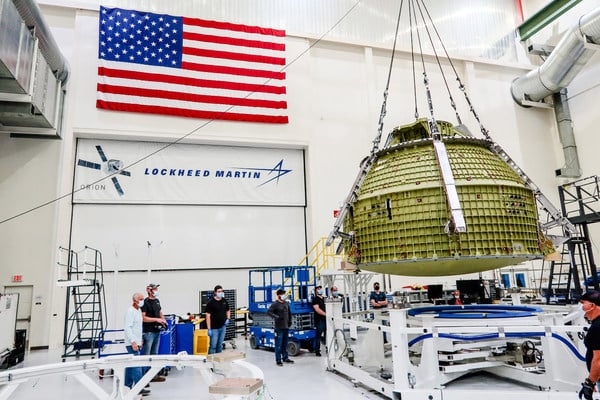Aerospace
NASA Orders Three More Orion Spacecraft From Lockheed Martin
NASA Orders Three More Orion Spacecraft From Lockheed Martin.

Now that Lockheed Martin (NYSE: LMT) has a contract to provide NASA with three Orion spacecraft for its Artemis VI–VIII missions, the agency can continue to get exploration vehicles to help with the Artemis programme by sending astronauts into deep space and around the Moon.
The Brazilian armed forces acquire 27 H125 helicopters(Opens in a new browser tab)
It is a privilege for Lockheed Martin to work with NASA to provide Orion spacecraft for the Artemis missions. This contract, which extends into the 2030s, includes spacecraft, mission planning, and support, according to Lisa Callahan, vice president and general manager of Lockheed Martin’s Commercial Civil Space division. “This contract demonstrates NASA is making long-term planning toward living and working on the Moon, while still having a forward emphasis on getting humans to Mars,” the statement reads. “We’re on the eve of a historic launch starting off the Artemis era.
As a result of OPOC, Lockheed Martin and NASA were able to build Orion vehicles for Artemis III through Artemis V at a 50% lower cost per unit than those constructed during the design and development stage. An additional 30% of the cost will be cut from the vehicles made for Artemis VI, VII, and VIII.
Japan completes hypersonic engine test successfully(Opens in a new browser tab)
Additionally, the company will reduce the cost of these production vehicles through bulk supplier purchases of materials and components as well as a quicker mission cadence.
Two additional Orion spacecraft, Artemis II and III, are being assembled at NASA’s Kennedy Space Center in Florida beside Artemis I, which is now perched on the Space Launch System rocket. Work on the Artemis IV craft is well under way, with the pressure vessel being joined at NASA’s Michoud Assembly Site close to New Orleans and the heat shield at a Lockheed Martin facility close to Denver. Work on the Artemis V vehicle has also already started.

Aerospace
Boeing Transfers Rocket Stage to NASA, Paving Way for Human Moon Mission

Boeing has achieved a significant milestone by providing NASA with the second core stage of the Space Launch System (SLS) rocket.
This crucial component, crafted at NASA’s Michoud Assembly Facility (MAF), is set to propel the Artemis II crew into lunar orbit, marking humanity’s return to deep space after a 50-year hiatus.
The monumental Boeing-built rocket stage, the largest element of the Artemis II mission, will embark on a journey aboard the Pegasus barge, traveling 900 miles to NASA’s Kennedy Space Center.
Comparison of two legendary aircraft B777x vs B747 aircraft:Click here
Upon arrival, it will be meticulously integrated with other essential Artemis II components, including the upper stage, solid rocket boosters, and NASA’s Orion spacecraft within the iconic Vehicle Assembly Building. This intricate integration process is a vital step toward the eagerly anticipated Artemis II launch, slated for 2025.
“Boeing-built products helped land humankind on the moon in 1969, and we’re proud to continue that legacy through the Artemis generation,” remarked Dave Dutcher, vice president and program manager for Boeing’s SLS program. “Together, with NASA and our industry partners and suppliers, we are building the world’s most capable rocket and paving the way to deep space through America’s rocket factory in New Orleans.”
NASA, Lockheed Martin Reveal X-59 Quiet Supersonic Aircraft:Click here
The delivery of Core Stage 2 marks a significant achievement in the evolution of the SLS rocket. Towering over 200 feet and powered by four RS-25 engines, this core stage, coupled with two solid-fueled booster rockets, will generate a staggering 8.8 million pounds of thrust. This immense power is crucial to launching Artemis II and future missions into the vast expanse of space.
The SLS rocket stands unparalleled in its capability to transport both crew and substantial cargo to the moon and beyond in a single launch. Its extraordinary capacity will facilitate the delivery of human-rated spacecraft, habitats, and scientific missions to destinations including the moon and Mars, ushering in a new era of space exploration.
-

 Travel1 week ago
Travel1 week agoAir India to Expand US Operations with Three New Routes After a Decade
-

 Travel2 weeks ago
Travel2 weeks agoWhy We Should Avoid These Stamps in a Passport
-

 Airlines1 month ago
Airlines1 month agoInvestigations Reveal Fake Chinese Titanium in Boeing and Airbus Jets
-

 Tech4 weeks ago
Tech4 weeks agoChina’s CATL Plans 1,800-Mile Electric Plane Launch by 2027
-

 Airport3 days ago
Airport3 days agoTop 10 Largest Airports in the World by Size
-

 Aerospace4 weeks ago
Aerospace4 weeks agoChina’s Fighter Jets Turn Wings into Autonomous Drones
-

 Airlines4 days ago
Airlines4 days agoAir India Rolls Out A350s for Delhi-New York JFK and Newark Routes
-

 Defence3 weeks ago
Defence3 weeks agoBoeing Enhances Chinook with New Engines and Block II Upgrades at $96 Million







